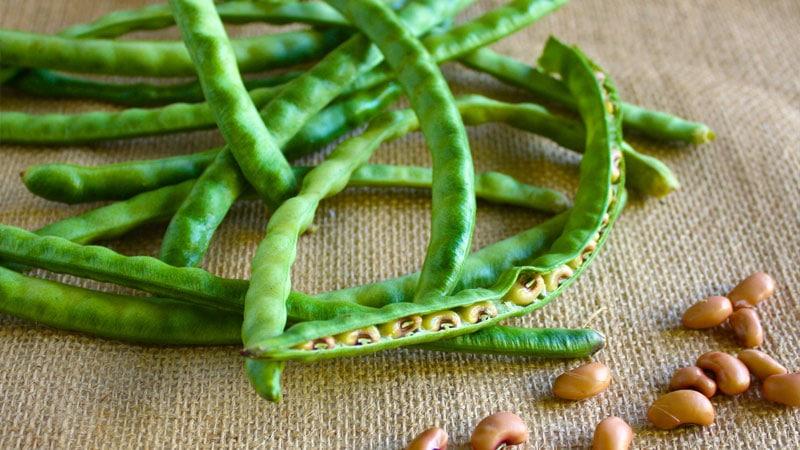Step-by-step instructions on how to grow beans at home and on your own plot: from sowing to harvesting
Among the healthy vegetables, rich in vitamins and microelements and at the same time not requiring special care, the bean legume stands out. This type of crop is native to Central and South America. People have been eating it for seven thousand years. The variety of varieties is also striking, among which there are two main ones: climbing and bush.
Since the plant is completely unpretentious and does not require constant attention, even a novice gardener can grow it in open ground and on a windowsill.
Which beans are best to grow at home?
Before you learn how to grow beans, you need to select the appropriate variety, descriptions and photographs of which you will find in this section.
Variety selection
The ideal solution for planting on a glassed-in loggia is sugar or asparagus bush crops.
 The following varieties are popular:
The following varieties are popular:
- Caramel. Green beans produce pods with a sugary taste already two months after germination, and they are resistant to all diseases. The plant reaches a height of 45-60 cm.
- Shahinya. Ripe white fruits have increased sugar content. It takes 70-80 days from germination to ripening. Plants are resistant to disease and heat. The bushes grow 28-30 cm in length.
- Butter king. The compact plant reaches a height of 40 cm, and the period from germination to fruiting is on average 50 days.Asparagus crop is resistant to diseases and tolerates the lack of regular watering.
- Belozernaya 361. The plant is bushy, 35-40 cm high. The growing season (from growth stage to development) is 50-54 days. The beans are fleshy and yellow in color.
- Homestead. Plants with branched stems, 40-50 cm high. Green beans with excellent taste.
Important! When planting at home, you should give preference to bush beans, since the variety is early ripening, productive and, unlike climbing varieties, will not shade other seedlings. Also, blossoming vines fill the empty space on the balcony.
Gardeners who decide to grow beans at home for the first time are recommended to purchase more than two varieties and sow 2-3 seeds of each. This way you will learn in practice which of the planted types will take root better and give a larger harvest.
Shelling varieties of beans are not planted indoors, it is advisable to give preference to asparagus culture. The reasons for this are the long growing season (on average three months) and the lack of a serious grain harvest that pays off the efforts in cramped conditions.
Growing beans indoors
Growing beans indoors is easy because the flowers are self-pollinating. The root system is not too powerful; a flower pot is enough for one bush.
Sowing time for growing on windowsills and balconies
The plant is sown in late spring on the loggia. If there is no balcony in the apartment, but you want to enjoy delicious fruits, containers or pots are placed on the windowsill in the room, but in this case the seeds are planted already in mid-March.
Important! The length of day required for growing beans is observed from mid-February to mid-March.However, for a legume plant frost destructive. Therefore, you can place pots of seeds on the balcony in mid-May, and if it is not glazed, then at the end of this month.
Container and soil for beans
 The legume plant grows quickly, so it is recommended to sow the seeds immediately in a permanent container. Each bush will require at least 3-5 liters of soil. Can be planted in a common box or individual pots at least 20 cm deep.
The legume plant grows quickly, so it is recommended to sow the seeds immediately in a permanent container. Each bush will require at least 3-5 liters of soil. Can be planted in a common box or individual pots at least 20 cm deep.
Tight containers create unfavorable conditions for future plants; vegetables will grow weak and unproductive, In addition, you will have to frequently water and feed the bushes, which will ultimately become an ineffective task. Thickened plantings of beans need to be watered and fed more often.
Pots and boxes must have drainage holes. If they are not there, pour a 2-3 cm layer of expanded clay onto the bottom. Buy a universal soil, or better yet, a special one for vegetable seedlings.
If desired, make your own soil mixture:
- one part of turf land;
- one part of humus;
- Add a glass of wood ash to a bucket of mixture.
Caring for beans from the moment of planting
 The first feeding is carried out when the leaves appear. Then the procedure is repeated every two weeks.
The first feeding is carried out when the leaves appear. Then the procedure is repeated every two weeks.
Nitrogen fertilizers are used during the growth stage. Among them, horse manure extract is popular - a natural, odorless fertilizer suitable for feeding plants on the windowsill and balcony.
When buds appear and until the end of the development period, nitrogen liquids are replaced with potassium fertilizers, for example, wood ash. The soil is sprinkled with one or two tablespoons, then loosened and watered.
If the bean bushes are unstable, they are tied to pegs.For climbing varieties, trellises are constructed using twine, plastic mesh, and decorative supports for indoor vines.
Harvest green beans Harvested two weeks after flowering ends. The lower pods are the first to ripen, and their leaves become hard and yellow.
Harvest beans as they ripen; do not let the fruits, ready for harvest, hang around for too long. The sooner the fruits are picked, the faster the next ones will grow and ripen.
Optimal light mode
Beans love bright sun, but not for long. If grow in winter on the windowsill, then place the plants on a south, sunny and warm window. On cloudy days, turn on the phytolamp.
In late spring and summer, keep the seedlings on an east or west window to create the effect of a short day.
Watering mode
When planting beans in open ground, the plant itself seeks moisture and nutrition, for example, it extracts what it needs from different layers of soil and is saturated with rain. However, being in a closed space - in a pot or box - it completely depends on the person.
The soil dries out quickly, especially if the plant is located on a balcony in the open air. The nutrients in the ground at the time of planting quickly run out. Therefore, the bushes need to be watered more often.
Important! Water the vegetables as the top layer of soil dries out. On the balcony, pay attention to the weather. Protect from heavy rains, prevent the risk of soil being washed out of pots and water stagnating at the roots. To do this, place the boxes with beans inside the balcony so that they are under the roof.
How to plant and care for beans in open ground
Now let's find out how to plant beans and when to plant them seeds in open ground at the dacha, as well as how to effectively care for the plant and store the fruits.
Timing for planting in open ground
Beginner gardeners often have a question about when to plant beans. The answer is: since this is a heat-loving crop, it is placed in open ground provided that the soil at a depth of 8-10 cm is heated to 9-10°C. Depending on the climate, the optimal time for sowing beans is May-June.
If you plan to plant vegetable seedlings in the greenhouse, then this should be done in April.
Choosing a place on the plot for beans
Growing beans in open ground will be successful if the area is illuminated by the sun all day long and there is a building, fence or hedge of bushes on the leeward side.
To obtain a harvest, bean seeds are placed in fertile and loose soil, and it is important that the soil is water-retentive. Only slightly alkaline soil is suitable for the growth and development of the crop. Thus, loamy and sandy loam soil are the best options for cultivation. If the soil is heavy, add sand, compost, peat chips, and sawdust.
Preparing the soil for beans
The planting area is prepared in advance:
- Weeds with roots are removed from the garden bed.
- Organic fertilizer is applied: 5 kg of manure or humus is required per 1 m².
- They dig up the soil. The clods of earth are not broken up, but left to freeze over the winter in order to destroy the pest larvae. In spring, the clods are broken up and the area is leveled with a rake.
- Before planting, add 30 g of superphosphate and 25 g of potassium chloride per 1 m². Instead of these fertilizers, you can use 2 cups of wood ash.
Seed preparation and sowing
 Many tips have been written on how to plant beans so that they germinate faster.
Many tips have been written on how to plant beans so that they germinate faster.
Common recommendations include the following steps:
- Seeds are sorted and those that are cracked, broken or irregular in shape are discarded.
- Soak overnight in water at room temperature. If it is not possible to soak overnight, then before planting the seed is dipped in hot water for 10 minutes, the temperature of which should be 60-70°C.
- Then soak for 5 minutes in a solution of boric acid, which is prepared at the rate of 1 g of boron powder per 5 liters of water. Instead of a solution of boric acid, the seeds are kept for 5 minutes in a raspberry solution of potassium permanganate, but after this procedure they must be washed.
To speed up the process of seed germination, the beans are kept in a growth stimulant, for example, Epin or Zircon.
Seeds are planted according to the following scheme:
- distance between holes – from 18 to 20 cm;
- row spacing – from 45 to 50 cm;
- The depth of the beans is 4–5 cm.
After planting, the bed is watered abundantly. To speed up the emergence of seedlings, the ground is covered with polyethylene, creating greenhouse conditions.
Care and watering
The basis for growing beans is regular watering, loosening and weeding between rows; in the case of climbing beans, tying them to supports or trellises in the greenhouse. The first shoots appear, as a rule, after 1-3 weeks. Already during this period, weak shoots are removed. As soon as the bush reaches a height of 10 cm, it is hilled to give the plant stability.
Before flowering, it is recommended to water the plant once a week, and after - twice. During the fruiting period, beans are watered more often than usual, but do not overwater.
Plant nutrition
Fertilizing is done with potassium and phosphorus fertilizers, although this plant is so unpretentious that it should be fed only in rare cases.For example, on dry and hot summer days, you can spill a solution of ash on the bushes.
Reference. During the first feeding, fertilizers are applied 4-6 cm from a row of plants, during the second - within a radius of 8-10 cm.
Bush formation
To ensure the stability of the bush and prevent it from collapsing during wind and heavy rain, the plant is hilled up. This is done for the first time when the bushes reach a height of 30 cm. In the future, as needed.
If the foliage of the bushes growing nearby has closed, hilling is no longer required - the plants will support themselves. A vertical support is installed near each plant and tied up.
Diseases and pests: control and prevention
Beans are susceptible to fungal infections:
- Anthracnose. It appears as brown spots on the leaves and stems; the fruits are deeply damaged and filled with pinkish mucus.
- Root rot. Symptoms are expressed in the form of shedding of leaves and fruits, the roots and basal neck are covered with a white-pink coating.
- White rot. The mycelium is white in color and affects the stems and fruits of the crop.
To combat fungal infections, preparations containing copper are used.
 The most dangerous bean pests are:
The most dangerous bean pests are:
- bean grain;
- melon aphid;
- whitefly
To combat, plants are treated with chemicals - insecticides. During this period, it is recommended to temporarily stop the procedure for attracting pollinating insects.
Slugs also attack beans, but their appearance can be easily prevented by regularly weeding the beds.
First harvest
Bean pods are harvested already two weeks after ripening, but they should be eaten as soon as possible, since they will not be stored for a long time.If it is necessary for the harvest to be preserved for a long time, the collected pods are left to dry, and the beans in them are left to ripen. In this case, the plant is laid out under a canopy and left until the pods dry.
Reference. To determine if the beans are ready to harvest, break the pod in half. If ready, it will break easily, and the break will have smooth edges.
Tips for caring for pod varieties
In order for green beans to bear fruit, you need to properly care for them:
- Select a sunny area for sowing with the required soil temperature.
- Before planting beans, it is advisable to fertilize the soil with minerals at the rate of one part nitrogen fertilizer, two parts phosphorus fertilizer and one part potassium fertilizer.
- For bush varieties, provide hilling and, if necessary, install pegs. Climbing green beans require solid support. The support must be strong to support the weight of the plant and not fall from strong winds.
- Before plants enter the flowering phase, the optimal frequency of watering is once a week. After flowering begins, the amount of water is doubled. Also, after each watering, you need to loosen the soil so that a crust does not form, preventing the flow of air to the roots.
- Superphosphate fertilizer is added after the ovary with leaves appears. The second feeding with potassium salt is done during bud setting.
- When the plants reach a height of two meters, you need to pinch the top. This will provoke the formation of ovaries.

Conclusion
Beans are equally easy to grow both on the plot and on the windowsill, and to get a good harvest, you need to follow simple recommendations for planting and care.
No less important conditions for growing are sowing in a sunny place, maintaining a sufficient amount of moisture in the soil, timely fertilizing, combating diseases, pests and their prevention.